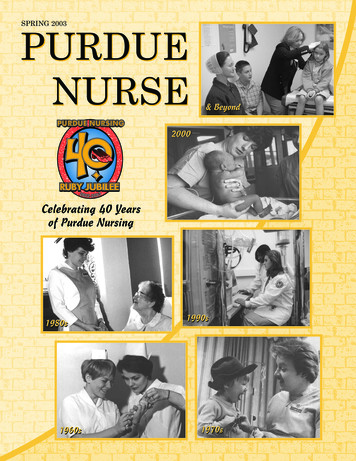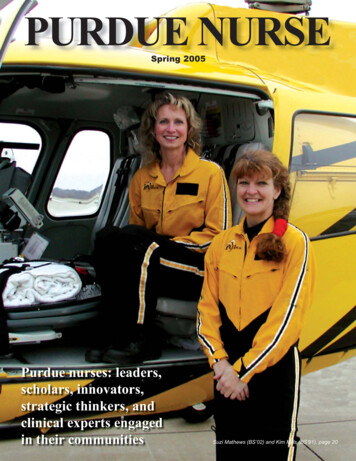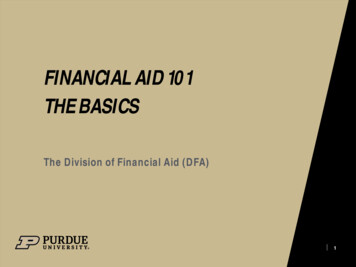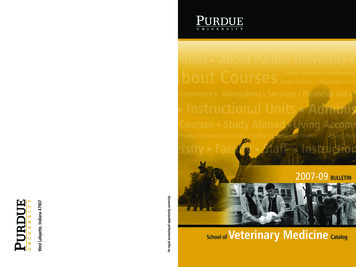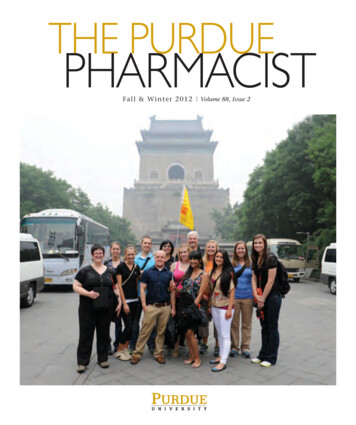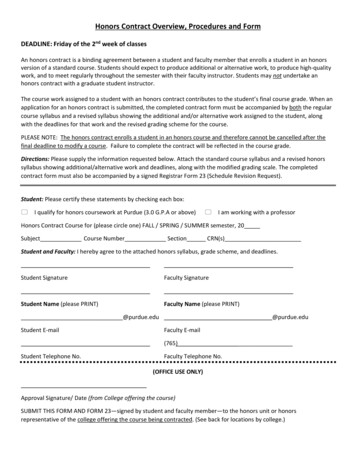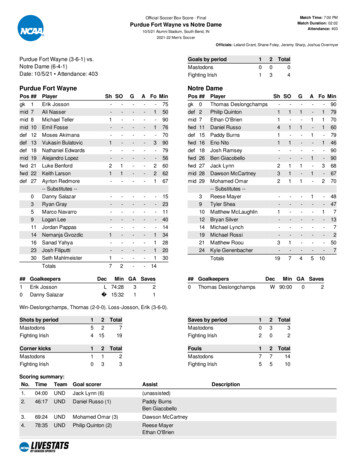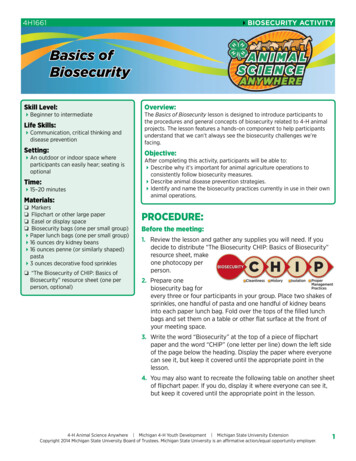
Transcription
4BIOSECURITY ACTIVITY4H1661Basics ofBiosecuritySkill Level: Beginner to intermediateLife Skills: Communication, critical thinking anddisease preventionSetting: An outdoor or indoor space whereparticipants can easily hear; seating isoptionalTime: 15–20 minutesMaterials: Markers Flipchart or other large paper Easel or display space Biosecurity bags (one per small group) Paper lunch bags (one per small group) 16 ounces dry kidney beans 16 ounces penne (or similarly shaped)pasta 3 ounces decorative food sprinkles “The Biosecurity of CHIP: Basics ofBiosecurity” resource sheet (one perperson, optional)Overview:The Basics of Biosecurity lesson is designed to introduce participants tothe procedures and general concepts of biosecurity related to 4-H animalprojects. The lesson features a hands-on component to help participantsunderstand that we can’t always see the biosecurity challenges we’refacing.Objective:After completing this activity, participants will be able to: Describe why it’s important for animal agriculture operations toconsistently follow biosecurity measures. Describe animal disease prevention strategies. Identify and name the biosecurity practices currently in use in their ownanimal operations.PROCEDURE:Before the meeting:1. Review the lesson and gather any supplies you will need. If youdecide to distribute “The Biosecurity CHIP: Basics of Biosecurity”resource sheet, makeone photocopy perperson.2. Prepare onebiosecurity bag forevery three or four participants in your group. Place two shakes ofsprinkles, one handful of pasta and one handful of kidney beansinto each paper lunch bag. Fold over the tops of the filled lunchbags and set them on a table or other flat surface at the front ofyour meeting space.3. Write the word “Biosecurity” at the top of a piece of flipchartpaper and the word “CHIP” (one letter per line) down the left sideof the page below the heading. Display the paper where everyonecan see it, but keep it covered until the appropriate point in thelesson.4. You may also want to recreate the following table on another sheetof flipchart paper. If you do, display it where everyone can see it,but keep it covered until the appropriate point in the lesson.4-H Animal Science Anywhere Michigan 4-H Youth Development Michigan State University ExtensionCopyright 2014 Michigan State University Board of Trustees. Michigan State University is an affirmative action/equal opportunity employer.1
4BIOSECURITY ACTIVITYWhat’s in the bag?ItemWhat it representsHow it relates to biosecurityBrown paper lunchbagThe environment (such as barns, trailers,stalls or pens, lots and pastures) andequipment (such as brushes, clippers,show sticks, blankets, halters, feed bucketsand water troughs) that animals comeinto contact with and that could carry andspread germsCan carry disease-causing pathogensfrom one animal to another if not cleanedcarefully between uses.PastaPeopleCan get sick from pathogens carried in theair, on equipment and by other humansand animals. Can carry the pathogensthat spread illnesses to other people andanimals.BeansAnimalsCan get sick from pathogens carried in theair, on equipment and by other animalsand humans. Can carry the pathogensthat spread illnesses to other animals andpeople.SprinklesPathogens (disease-causing bacteria andCan cause diseases and be spread fromviruses) – Note that the sprinkles are visible, farm to farm and animal to animal withoutbut real pathogens are too small to be seen proper biosecurity measures.without a microscope.During the meeting:1. Introduce the activity by reading aloud or paraphrasing thefollowing:Nearly every animal and human gets sick at some point.When an illness is caused by a pathogen (a virus or bacteria), it can spread quickly through a herd or flock, orfrom animal to human or human to animal. Some pathogens travel through the air (after a sneeze, for example)and some travel from pen to pen or even farm to farm onpeople’s shoes or on the tools or equipment they movefrom one site to another.The management practices you follow to help preventthe spread of pathogens and keep your animals healthyare called “biosecurity measures.” Today we’re going totalk about some of the biosecurity measures you shouldfollow with your 4-H project animals and any other animals under your care. We’ll start by working with biosecurity bags to discover the major players in biosecurity.2. Divide the group into three- or four-person teams (depending onthe size of your group and the number of biosecurity bags you’veprepared). Have each group form a circle, then ask one personfrom each group to collect a biosecurity bag for the team.24-H Animal Science Anywhere Michigan 4-H Youth Development Michigan State University ExtensionCopyright 2014 Michigan State University Board of Trustees. Michigan State University is an affirmative action/equal opportunity employer.
4BIOSECURITY ACTIVITY3. Tell the group that when you say “go,” they should open their bagsand – without taking anything out – look at what’s inside and talkabout how those things could relate to biosecurity.4. Give the teams a few moments to examine the contents of theirlunch bags, then use the “What’s in a Bag” table to guide a groupdiscussion of how each item in the bags relates to biosecurity.(Note: If you made one, uncover the “What’s in the Bag” flipchartpaper so that everyone can refer to it during the discussion.)5. Now tell the teams to close their lunch bags, give the bags a goodshake, then reopen them and look to see if anything inside haschanged.6. Ask for volunteers to answer the following questions: After you shook your team’s lunch bag, could you still see thedisease-causing pathogens (sprinkles)? (Some teams mayanswer yes, and others no.) Even if you couldn’t see the pathogens, were they still there?Why is that important? (Because pathogens such as virusesand bacteria are so small that we can’t see them without amicroscope. And even though we can’t see pathogens, they stillhave the potential to make both animals and humans ill.)7. Next, read aloud or paraphrase the following:So why should we be concerned about biosecurity? AsI said earlier, biosecurity is the set of steps we take toprevent animals from being infected with or spreadingpathogens. Biosecurity is also a vital step in ensuring thatour food supply is safe. Now we’re going to learn aboutthe biosecurity measures we can use with the help of theBiosecurity CHIP.8. Reveal the flipchart paper headed “Biosecurity” that has the word“CHIP” written down the side. As you discuss the meaning of eachletter, write the corresponding word next to it. Continue with thelesson by reviewing “The Biosecurity CHIP: Basics of Biosecurity”resource sheet with the group. (Note: You may wish to pass outcopies of the resource sheet now or after you’ve reviewed it withthe group.)9. Ask for volunteers to list some ways that they could practice theBiosecurity CHIP principles. (Separate new animals, don’t take barnboots inside the house, wear different shoes or boots at the fairthan you do around your own barn, ask questions about any animalsyou’re considering buying before you buy them, contact breeders toask other questions, disinfect equipment between animals, requireall visitors to wear disposable boots you provide). Record theiranswers on flipchart paper and display the sheet where everyonecan see it.4-H Animal Science Anywhere Michigan 4-H Youth Development Michigan State University ExtensionCopyright 2014 Michigan State University Board of Trustees. Michigan State University is an affirmative action/equal opportunity employer.3
4BIOSECURITY ACTIVITYTALKING IT OVER:Ask the group the following questions. Why is it important for humansto consider animal well-beingand health as they plan their ownactions and activities aroundanimals? What steps can you put into placeto improve the biosecurity of your4-H project animals? What biosecurity practices can youhelp put into place at local fairs orother animal-related communityevents you attend or participate in?10. To summarize, read aloud or paraphrase the following:By following the measures outlined in the BiosecurityCHIP, you’ll help keep yourself and your animals healthyand help ensure the safety of our food supply. If your animals are exposed to a contagious illness, though, you’llneed to work closely with your veterinarian to containthe outbreak. This will be easier if you already have anemergency plan in place and already have a veterinarian/client (you)/patient (animal) relationship.ADAPTATIONS & EXTENSIONS: For older or more experienced participants:- Have participants brainstorm a list of ways that biosecuritypractices can be improved at the local fair or other animalrelated events. Then have them research and prepare apresentation on the topic that they could share with the fairboard or 4-H livestock or species-specific council.- Provide poster board, markers and other items for theparticipants to use in creating biosecurity signs for display at alocal fair or educational event.Basics of Biosecurity 2014 by Michigan State University Board of Trustees. 4-H and Cooperative Extension System groups and other nonprofit educationalgroups may print up to 25 hard copies of this material for noncommercial, educational use, provided thatattribution is given to Michigan State University. Allother rights reserved. For information, contact 4-HYouth Development, 108 Morrill Hall of Agriculture, 446 West Circle Drive, East Lansing, MI 48824.MSU is an affirmative-action, equal-opportunity employer, committed to achieving excellence through adiverse workforce and inclusive culture that encourages all people to reach their full potential. MichiganState University Extension programs and materialsare open to all without regard to race, color, nationalorigin, gender, gender identity, religion, age, height,weight, disability, political beliefs, sexual orientation,marital status, family status or veteran status. Issuedin furtherance of MSU Extension work, acts of May8 and June 30, 1914, in cooperation with the U.S.Department of Agriculture. Thomas G. Coon, Director, MSU Extension, East Lansing, MI 48824. Thisinformation is for educational purposes only. Reference to commercial products or trade names does notimply endorsement by MSU Extension or bias againstthose not mentioned. The 4-H Name and Emblemhave special protections from Congress, protectedby code 18 USC 707. 1P–Web–06:2014–RM/MR4 For younger or less experienced participants: Help participantscome up with a creative song, slogan or catchphrase about keepingthemselves and their animals safe. For example, a poster couldshow a pig with the caption, “Help keep me healthy, wash yourhands before you visit.”REFERENCES & RESOURCES:American Association of Swine Veterinarians & National Pork Board.(2013). A champions guide to youth swine exhibition: Biosecurity & your pig project. Des Moines, IA: National Pork Board.Retrieved from de%20to%20Youth%20Swine%20Exhibition.pdfMichigan Department of Agriculture and Rural Development, Animal Industry Division (2014). 2014 exhibition requirements.Lansing, MI: Author. Retrieved from michigan.gov/mdard/0,4610,7-125-1571 7075-300958--,00.htmlShulaw, W. P., & Bowman, G. L. (2001). Biosecurity for youth livestockexhibitors. Columbus: Ohio State University, OSU Extension.Retrieved from :Author: Julie Thelen, 4-H Livestock and Veterinary Science Educator,Michigan State University ExtensionThis bulletin was produced by ANR Communications(anrcom.msu.edu).4-H Animal Science Anywhere Michigan 4-H Youth Development Michigan State University ExtensionCopyright 2014 Michigan State University Board of Trustees. Michigan State University is an affirmative action/equal opportunity employer.
4BASICS OF BIOSECURITY RESOURCE SHEETThe Biosecurity CHIPBiosecurity related to animal and humaninteractions is broken down into four basicprinciples. One way you can remember theseprinciples is by thinking of the word “CHIP.”“C” is for cleanliness.Cleanliness starts with keeping both your animalsand the equipment you use on and around themclean. Sharing grooming equipment is one of themost common ways that pathogens spread, becausetheir surfaces can be easily contaminated with hair,dander and other debris. Avoid sharing equipmentwith others at shows or other animal events withoutproperly cleaning it between animals (for example, bysoaking it in a 6-percent bleach solution, then rinsing itthoroughly). If your animals will be sharing equipmentsuch as trailers and feed and water buckets, make surethe items are safe, are clean and have been recentlydisinfected before using them.Human health and personal hygiene are also part ofthe cleanliness step of biosecurity. Ringworm, E. coli,salmonella and other pathogens can pass from animalsto humans and humans to animals. Wash your handswith soap and water after handling animals, and keepyour clothing and shoes clean to help prevent thespread of pathogens.“H” is for history.Ask questions about any animals you’re consideringbuying before you purchase them. The first step indisease prevention is to be as familiar as possible withthe general animal health and management practicesof the operation you’re buying from. Knowing thediseases that animals have been vaccinated against isanother way to prevent a variety of pathogens and bemore prepared for future health concerns. Again, don’tbe afraid to ask questions! They’ll save you time andmoney in the long run.Check with all visitors to your farm to see if theyhave traveled to an area that may be infected with apathogen that could spread to you or your animals (forexample, foot and mouth disease is still a problem inthe United Kingdom).“I” is for isolation.When new animals arrive on your farm, keep themseparate from other animals for at least 14 days, andif possible, 30 days. This helps reduce the number ofanimals that would get sick if a newcomer brought acontagious disease into your facility. When returningfrom a show or other off-farm event, initially keep thereturning animals separate to avoid passing along anyinfections they may have been exposed to.Keep your clothes and shoes or boots separate, too.Don’t wear the same boots you wear in your barn to ashow or fair, if possible. Diseases like the deadly PorcineEpidemic Diarrhea virus (PEDv) are spread via fecalmatter, and shoes and boots are the most common carriers of manure, and therefore, the pathogen. Considerdrawing a line that no barn shoes are allowed to crossto help avoid such contamination.“P” is for proper managementpractices.Proper animal management practices include observingyour animals for signs of sickness, conducting appropriate vaccination programs and providing proper animalnutrition.Controlling visitors’ access to areas where your animalsare housed and often travel is another importantmanagement practice. Be sure that your own and allvisitors’ shoes and boots are clean before and aftervisiting any farm. If you’re not sure visitors’ shoes andboots are clean, requiring everyone to wear disposableplastic boots that you provide is a good biosecuritysafeguard. Some pathogens can also travel on clothesand on humans, so take extra precautions if there is ananimal disease outbreak in your area or anywhere youor your animals are traveling.4-H Animal Science Anywhere Michigan 4-H Youth Development Michigan State University ExtensionCopyright 2014 Michigan State University Board of Trustees. Michigan State University is an affirmative action/equal opportunity employer.5
Basics of Biosecurity Overview: The Basics of Biosecurity lesson is designed to introduce participants to the procedures and general concepts of biosecurity related to 4-H animal projects. The lesson features a hands-on component to help participants understand that we can't always see the biosecurity challenges we're facing. Objective:

